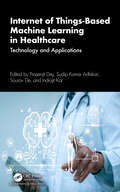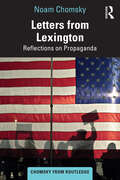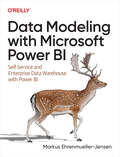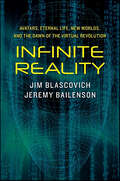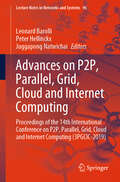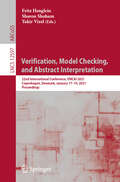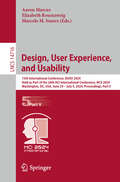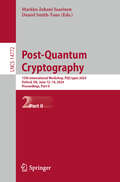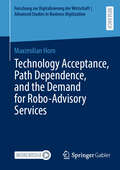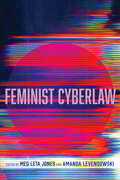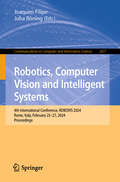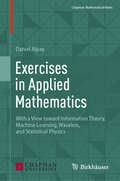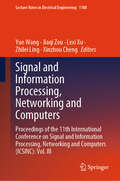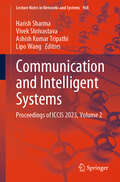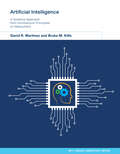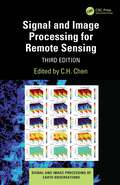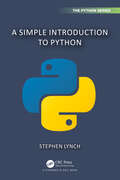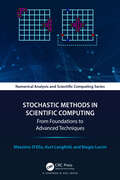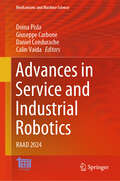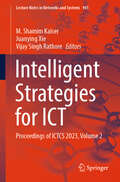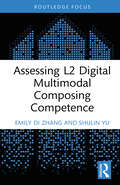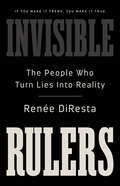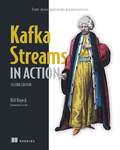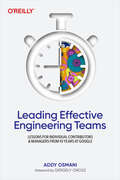- Table View
- List View
Internet of Things-Based Machine Learning in Healthcare: Technology and Applications
by Prasenjit Dey, Sudip Kumar Adhikari, Sourav De, and Indrajit KarThe Internet of Medical Things (IoMT) is a system that collects data from patients with the help of different sensory inputs, e.g., an accelerometer, electrocardiography, and electroencephalography. This text presents both theoretical and practical concepts related to the application of machine learning and Internet of Things (IoT) algorithms in analyzing data generated through healthcare systems. Illustrates the latest technologies in the healthcare domain and the Internet of Things infrastructure for storing smart electronic health records Focuses on the importance of machine learning algorithms and the significance of Internet of Things infrastructure for healthcare systems Showcases the application of fog computing architecture and edge computing in novel aspects of modern healthcare services Discusses unsupervised genetic algorithm-based automatic heart disease prediction Covers Internet of Things–based hardware mechanisms and machine learning algorithms to predict the stress level of patients The text is primarily written for graduate students and academic researchers in the fields of computer science and engineering, biomedical engineering, electrical engineering, and information technology.
Letters from Lexington: Reflections on Propaganda (Chomsky from Routledge)
by Noam ChomskyUpon its original publication in 1993, Letters from Lexington reaffirmed Noam Chomsky's status as one of the most incisive critics of the American media. Reissued with a new foreword by Chomsky’s long-term collaborator, radio broadcaster David Barsamian, this prescient book remains startlingly relevant in our current age of disinformation and “fake news.”Throughout the book, Chomsky critiques the media’s complicity in US domestic and foreign policy. In particular, Chomsky's analyses of the politics of the Reagan and earlier Bush administrations offer illuminating perspectives on the events, key players, and policies that would continue to shape America's national agenda during the presidency of George W. Bush and the “War on Terrorism.”Letters from Lexington remains an indispensable guide to the American propaganda machine and the shibboleths of the mainstream media. As such, this book will appeal to students and scholars with an interest in the media and US domestic and foreign policy, as well as serve as a vital tool for activists and general readers seeking to question dubious narratives put forward by the mainstream media.
Data Modeling with Microsoft Power BI
by Markus Ehrenmueller-JensenData modeling is the single most overlooked feature in Power BI Desktop, yet it's what sets Power BI apart from other tools on the market. This practical book serves as your fast-forward button for data modeling with Power BI, Analysis Services tabular, and SQL databases. It serves as a starting point for data modeling, as well as a handy refresher.Author Markus Ehrenmueller-Jensen, founder of Savory Data, shows you the basic concepts of Power BI's semantic model with hands-on examples in DAX, Power Query, and T-SQL. If you're looking to build a data warehouse layer, chapters with T-SQL examples will get you started. You'll begin with simple steps and gradually solve more complex problems.This book shows you how to:Normalize and denormalize with DAX, Power Query, and T-SQLApply best practices for calculations, flags and indicators, time and date, role-playing dimensions and slowly changing dimensionsSolve challenges such as binning, budget, localized models, composite models, and key value with DAX, Power Query, and T-SQLDiscover and tackle performance issues by applying solutions in DAX, Power Query, and T-SQLWork with tables, relations, set operations, normal forms, dimensional modeling, and ETL
Infinite Reality: The Hidden Blueprint of Our Virtual Lives
by Jeremy Bailenson Jim Blascovich“Enough with speculation about our digital future. Infinite Reality is the straight dope on what is and isn’t happening to us right now, from two of the only scientists working on the boundaries between real life and its virtual extensions.”—Douglas Rushkoff, author of Program or Be ProgrammedCan our brains recognize where "reality" ends and "virtual" begins? Where will technology lead us in five, fifty, or five hundred years? An unrivaled guide to our digital future that has been cited by the Supreme Court, Infinite Reality is a mind-bending "journey through the virtual universe" (Wall Street Journal). Jim Blascovich and Jeremy Bailenson, two pioneering authorities, explore the profound potential of emerging technologies and reveal how our brains behave in digital worlds.Along the way, Bailenson and Blascovich examine the timeless philosophical questions of the self and "reality" that arise through the digital experience; explain how virtual reality's latest and future forms—including immersive video games and social-networking sites—will soon be seamlessly integrated into our lives; show the many surprising practical applications of virtual reality, from education and medicine to sex and warfare; and probe further-off possibilities like "total personality downloads" that would allow your great-great-grandchildren to have a conversation with "you" a century or more after your death.Equally fascinating, farsighted, and profound, Infinite Reality is an essential guide to our virtual future, where the experience of being human will be deeply transformed.
Advances on P2P, Parallel, Grid, Cloud and Internet Computing: Proceedings of the 14th International Conference on P2P, Parallel, Grid, Cloud and Internet Computing (3PGCIC-2019) (Lecture Notes in Networks and Systems #96)
by Leonard Barolli Juggapong Natwichai Peter HellinckxThis book presents the latest research findings, innovative research results, methods and development techniques related to P2P, grid, cloud and Internet computing from both theoretical and practical perspectives. It also reveals the synergies among such large-scale computing paradigms. P2P, grid, cloud and Internet computing technologies have rapidly become established as breakthrough paradigms for solving complex problems by enabling aggregation and sharing of an increasing variety of distributed computational resources at large scale.Grid computing originated as a paradigm for high-performance computing, as an alternative to expensive supercomputers through different forms of large-scale distributed computing. P2P computing emerged as a new paradigm after client–server and web-based computing and has proved useful in the development of social networking, B2B (business to business), B2C (business to consumer), B2G (business to government), and B2E (business to employee). Cloud computing has been defined as a “computing paradigm where the boundaries of computing are determined by economic rationale rather than technical limits,” and it has fast become a computing paradigm with applicability and adoption in all application domains and which provides utility computing at a large scale. Lastly, Internet computing is the basis of any large-scale distributed computing paradigms; it has developed into a vast area of flourishing fields with enormous impact on today’s information societies, and serving as a universal platform comprising a large variety of computing forms such as grid, P2P, cloud and mobile computing.
Verification, Model Checking, and Abstract Interpretation: 22nd International Conference, VMCAI 2021, Copenhagen, Denmark, January 17–19, 2021, Proceedings (Lecture Notes in Computer Science #12597)
by Fritz Henglein Sharon Shoham Yakir VizelThis book constitutes the proceedings of the 22nd International Conference on Verification, Model Checking, and Abstract Interpretation, VMCAI 2021, which was held virtually during January 17-19, 2021. The conference was planned to take place in Copenhagen, Denmark, but changed to an online event due to the COVID-19 pandemic. The 23 papers presented in this volume were carefully reviewed from 48 submissions. VMCAI provides a forum for researchers working on verification, model checking, and abstract interpretation and facilitates interaction, cross-fertilization, and advancement of hybrid methods that combine these and related areas. The papers presented in this volume were organized in the following topical sections: hyperproperties and infinite-state systems; concurrent and distributed systems; checking; synthesis and repair; applications; and decision procedures.
Design, User Experience, and Usability: 13th International Conference, DUXU 2024, Held as Part of the 26th HCI International Conference, HCII 2024, Washington, DC, USA, June 29 – July 4, 2024, Proceedings, Part V (Lecture Notes in Computer Science #14716)
by Aaron Marcus Marcelo M. Soares Elizabeth RosenzweigThis five-volume set LNCS 14712-14716 constitutes the refereed proceedings of the 13th International Conference on Design, User Experience, and Usability, DUXU 2024, held as part of the 26th International Conference, HCI International 2024, in Washington, DC, USA, during June 29 – July 4, 2024. The total of 1271 papers and 309 posters included in the HCII 2024 proceedings was carefully reviewed and selected from 5108 submissions. The DUXU 2024 proceedings were organized in the following topical sections: Part I: Information Visualization and Interaction Design; Usability Testing and User Experience Evaluation. Part II: Designing Interactions for Intelligent Environments; Automotive Interactions and Smart Mobility Solutions; Speculative Design and Creativity. Part III: User Experience Design for Inclusion and Diversity; Human-Centered Design for Social Impact. Part IV: Designing Immersive Experiences across Contexts; Technology, Design, and Learner Engagement; User Experience in Tangible and Intangible Cultural Heritage. Part V: Innovative Design for Enhanced User Experience; Innovations in Product and Service Design.
Post-Quantum Cryptography: 15th International Workshop, PQCrypto 2024, Oxford, UK, June 12–14, 2024, Proceedings, Part II (Lecture Notes in Computer Science #14772)
by Daniel Smith-Tone Markku-Juhani SaarinenThe two-volume set LNCS 14771 and 14772 constitutes the refereed proceedings of the 15th International Workshop, PQCrypto 2024, held in Oxford, UK, during June 12–14, 2024. The 28 full papers included in these proceedings were carefully reviewed and selected from 76 submissions. They were organized in topical sections as follows: Part I: Applications and protocols; code-based cryptography; group-action-based cryptography; lattice-based cryptography; Part II: Isogeny-Based cryptgraphy; multivariate cryptography; quantum algorithms; transforms and proofs.
Technology Acceptance, Path Dependence, and the Demand for Robo-Advisory Services (Forschung zur Digitalisierung der Wirtschaft | Advanced Studies in Business Digitization)
by Maximilian HornThis book explores the effects of the previously ignored factors of path dependence and product features on technology acceptance with a focus on robo-advice. A newly developed model introduces path dependence to technology acceptance research allowing to explain previously unaccountable effects. An empirical test of the model using data from Germany and the USA elicits that path dependence influences the attitudes towards and demand for robo-advice. A process consisting of a market survey, a choice-based conjoint analysis, and a test in a technology acceptance model allows the structured investigation of the effects of product features on the demand for robo-advice. The results show that selected product features have effects on the demand for robo-advice and that it is essential to establish these effects empirically.
Feminist Cyberlaw
by Meg Leta Jones and Amanda LevendowskiA free ebook version of this title is available through Luminos, University of California Press's Open Access publishing program. Visit www.luminosoa.org to learn more. This vibrant and visionary reimagining of the field of cyberlaw through a feminist lens brings together emerging and established scholars and practitioners to explore how gender, race, sexuality, disability, class, and the intersections of these identities affect cyberspace and the laws that govern it. It promises to build a movement of scholars whose work charts a near future where cyberlaw is informed by feminism.
Robotics, Computer Vision and Intelligent Systems: 4th International Conference, ROBOVIS 2024, Rome, Italy, February 25–27, 2024, Proceedings (Communications in Computer and Information Science #2077)
by Joaquim Filipe Juha RöningThis volume constitutes the proceedings of the 4th International Conference on Robotics, Computer Vision and Intelligent Systems, ROBOVIS 2024, which was held in Rome, Italy, during February 25-27, 2024. The 8 full papers and 21 short papers are presented in this book were carefully reviewed and selected from 33 submissions. They focus on topics on research and development in robotics, computer vision, and intelligent systems.
Exercises in Applied Mathematics: With a View toward Information Theory, Machine Learning, Wavelets, and Statistical Physics (Chapman Mathematical Notes)
by Daniel AlpayThis text presents a collection of mathematical exercises with the aim of guiding readers to study topics in statistical physics, equilibrium thermodynamics, information theory, and their various connections. It explores essential tools from linear algebra, elementary functional analysis, and probability theory in detail and demonstrates their applications in topics such as entropy, machine learning, error-correcting codes, and quantum channels. The theory of communication and signal theory are also in the background, and many exercises have been chosen from the theory of wavelets and machine learning. Exercises are selected from a number of different domains, both theoretical and more applied. Notes and other remarks provide motivation for the exercises, and hints and full solutions are given for many. For senior undergraduate and beginning graduate students majoring in mathematics, physics, or engineering, this text will serve as a valuable guide as theymove on to more advanced work.
Signal and Information Processing, Networking and Computers: Proceedings of the 11th International Conference on Signal and Information Processing, Networking and Computers (ICSINC): Vol. III (Lecture Notes in Electrical Engineering #1188)
by Yue Wang Lexi Xu Jiaqi Zou Zhilei Ling Xinzhou ChengThis book collects selected papers from the 11th Conference on Signal and Information Processing, Networking and Computers held in Chengdu, China, in September 2023. The book focuses on the current works of information theory, communication system, computer science, aerospace technologies, big data, and other related technologies. People from both academia and industry of these fields can contribute and find their interests from the book.The 11th International Conference on Signal and Information Processing, Networking and Computers (ICSINC) was held in Chengdu, China, in September 2023, which focused on the key technologies and challenges of signal and information processing schemes, network application, computer theory, space technologies, big data, and other related technologies
Communication and Intelligent Systems: Proceedings of ICCIS 2023, Volume 2 (Lecture Notes in Networks and Systems #968)
by Lipo Wang Harish Sharma Vivek Shrivastava Ashish Kumar TripathiThis book gathers selected research papers presented at the Fifth International Conference on Communication and Intelligent Systems (ICCIS 2023), organized by Malaviya National Institute of Technology Jaipur, India, during December 16–17, 2023. This book presents a collection of state-of-the-art research work involving cutting-edge technologies for communication and intelligent systems. Over the past few years, advances in artificial intelligence and machine learning have sparked new research efforts around the globe, which explore novel ways of developing intelligent systems and smart communication technologies. The book presents single- and multi-disciplinary research on these themes to make the latest results available in a single, readily accessible source. The work is presented in three volumes.
Artificial Intelligence: A Systems Approach from Architecture Principles to Deployment (MIT Lincoln Laboratory Series)
by David R. Martinez Bruke M. KifleThe first text to take a systems engineering approach to artificial intelligence (AI), from architecture principles to the development and deployment of AI capabilities.Most books on artificial intelligence (AI) focus on a single functional building block, such as machine learning or human-machine teaming. Artificial Intelligence takes a more holistic approach, addressing AI from the view of systems engineering. The book centers on the people-process-technology triad that is critical to successful development of AI products and services. Development starts with an AI design, based on the AI system architecture, and culminates with successful deployment of the AI capabilities. Directed toward AI developers and operational users, this accessibly written volume of the MIT Lincoln Laboratory Series can also serve as a text for undergraduate seniors and graduate-level students and as a reference book. Key features:In-depth look at modern computing technologies Systems engineering description and means to successfully undertake an AI product or service development through deploymentExisting methods for applying machine learning operations (MLOps)AI system architecture including a description of each of the AI pipeline building blocksChallenges and approaches to attend to responsible AI in practice Tools to develop a strategic roadmap and techniques to foster an innovative team environment Multiple use cases that stem from the authors&’ MIT classes, as well as from AI practitioners, AI project managers, early-career AI team leaders, technical executives, and entrepreneurs Exercises and Jupyter notebook examples
Signal and Image Processing for Remote Sensing (ISSN)
by C. H. ChenAdvances in signal and image processing for remote sensing have been tremendous in recent years. The progress has been particularly significant with the use of deep learning based techniques to solve remote sensing problems. These advancements are the focus of this third edition of Signal and Image Processing for Remote Sensing. It emphasizes the use of machine learning approaches for the extraction of remote sensing information. Other topics include change detection in remote sensing and compressed sensing. With 19 new chapters written by world leaders in the field, this book provides an authoritative examination and offers a unique point of view on signal and image processing.Features Includes all new content and does not replace the previous edition Covers machine learning approaches in both signal and image processing for remote sensing Studies deep learning methods for remote sensing information extraction that is found in other books Explains SAR, microwave, seismic, GPR, and hyperspectral sensors and all sensors considered Discusses improved pattern classification approaches and compressed sensing approaches Provides ample examples of each aspect of both signal and image processing This book is intended for university academics, researchers, postgraduate students, industry, and government professionals who use remote sensing and its applications.
A Simple Introduction to Python (Chapman & Hall/CRC The Python Series)
by Stephen LynchA Simple Introduction to Python is aimed at pre-university students and complete novices to programming. The whole book has been created using Jupyter notebooks. After introducing Python as a powerful calculator, simple programming constructs are covered, and the NumPy, MatPlotLib and SymPy modules (libraries) are introduced. Python is then used for Mathematics, Cryptography, Artificial Intelligence, Data Science and Object Oriented Programming.The reader is shown how to program using the integrated development environments: Python IDLE, Spyder, Jupyter notebooks, and through cloud computing with Google Colab.Features: No prior experience in programming is required. Demonstrates how to format Jupyter notebooks for publication on the Web. Full solutions to exercises are available as a Jupyter notebook on the Web. All Jupyter notebook solution files can be downloaded through GitHub. GitHub Repository of Data Files and a Jupyter Solution notebook: https://github.com/proflynch/A-Simple-Introduction-to-PythonJupyter Solution notebook web page: https://drstephenlynch.github.io/webpages/A-Simple-Introduction-to-Python-Solutions.html
Stochastic Methods in Scientific Computing: From Foundations to Advanced Techniques (Chapman & Hall/CRC Numerical Analysis and Scientific Computing Series)
by Massimo D'Elia Kurt Langfeld Biagio LuciniStochastic Methods in Scientific Computing: From Foundations to Advanced Techniques introduces the reader to advanced concepts in stochastic modelling, rooted in an intuitive yet rigorous presentation of the underlying mathematical concepts. A particular emphasis is placed on illuminating the underpinning Mathematics, and yet have the practical applications in mind. The reader will find valuable insights into topics ranging from Social Sciences and Particle Physics to modern-day Computer Science with Machine Learning and AI in focus. The book also covers recent specialised techniques for notorious issues in the field of stochastic simulations, providing a valuable reference for advanced readers with an active interest in the field.Features Self-contained, starting from the theoretical foundations and advancing to the most recent developments in the field Suitable as a reference for post-graduates and researchers or as supplementary reading for courses in numerical methods, scientific computing, and beyond Interdisciplinary, laying a solid ground for field-specific applications in finance, physics and biosciences on common theoretical foundations Replete with practical examples of applications to classic and current research problems in various fields.
Advances in Service and Industrial Robotics: RAAD 2024 (Mechanisms and Machine Science #157)
by Giuseppe Carbone Doina Pisla Calin Vaida Daniel ConduracheThis book presents the Proceedings of the 33rd International Conference on Robotics in Alpe-Adria-Danube Region (RAAD), held in Cluj-Napoca, Romania, June 5–7, 2024. It gathers contributions by researchers from multiple countries on all major areas of robotic research, development, and innovation, as well as new applications and current trends. The topics include perception and learning, medical robotics and biomechanics, industrial robots and education, kinematics and dynamics, motion planning and control, service robotics and applications, mobile robots and innovative robot design, etc. Given its scope, the book offers a source of information and inspiration for researchers seeking to improve their work and gather new ideas for future developments.
Intelligent Strategies for ICT: Proceedings of ICTCS 2023, Volume 2 (Lecture Notes in Networks and Systems #941)
by Vijay Singh Rathore M. Shamim Kaiser Juanying XieThis book contains best selected research papers presented at ICTCS 2023: Eighth International Conference on Information and Communication Technology for Competitive Strategies. The conference was held in Jaipur, India during 8 – 9 December 2023. The book covers state-of-the-art as well as emerging topics pertaining to ICT and effective strategies for its implementation for engineering and managerial applications. This book contains papers mainly focused on ICT for computation, algorithms and data analytics and IT security. The work is presented in three volumes.
Assessing L2 Digital Multimodal Composing Competence (Routledge Focus on Applied Linguistics)
by Emily Di Zhang Shulin YuThis book focuses on assessing L2 student digital multimodal composing (DMC) competence. It explores key themes, including the conceptualization of L2 student DMC competence, and the development, validation, and utilization of L2 student DMC competence in the tertiary context.Through a thorough review of the DMC literature, the book furnishes readers with a theoretical framework to comprehensively grasp the underlying constructs of L2 student DMC competence. It also provides a delineation of the process of scale development, i.e., defining constructs, constructing items, and analyzing items, scale validation, i.e., the structural, external, and consequential construct validity of the scale, and scale utilization in students’ DMC self- and peer-assessment practices.This practical guidance equips educators and practitioners with the necessary tools and strategies to effectively assess and enhance L2 students’ DMC competence. Scholars and professionals in the fields of L2 writing, language assessment, digital literacy, and technology-enhanced language learning will gain valuable insights from the content.
Invisible Rulers: The People Who Turn Lies into Reality
by Renee DiRestaAn &“essential and riveting&” (Jonathan Haidt) analysis of the radical shift in the dynamics of power and influence, revealing how the machinery that powered the Big Lie works to create bespoke realities revolutionizing politics, culture, and society. Renée DiResta&’s powerful, original investigation into the way power and influence have been profoundly transformed reveals how a virtual rumor mill of niche propagandists increasingly shapes public opinion. While propagandists position themselves as trustworthy Davids, their reach, influence, and economics make them classic Goliaths—invisible rulers who create bespoke realities to revolutionize politics, culture, and society. Their work is driven by a simple maxim: if you make it trend, you make it true. By revealing the machinery and dynamics of the interplay between influencers, algorithms, and online crowds, DiResta vividly illustrates the way propagandists deliberately undermine belief in the fundamental legitimacy of institutions that make society work. This alternate system for shaping public opinion, unexamined until now, is rewriting the relationship between the people and their government in profound ways. It has become a force so shockingly effective that its destructive power seems limitless. Scientific proof is powerless in front of it. Democratic validity is bulldozed by it. Leaders are humiliated by it. But they need not be. With its deep insight into the power of propagandists to drive online crowds into battle—while bearing no responsibility for the consequences—Invisible Rulers not only predicts those consequences but offers ways for leaders to rapidly adapt and fight back.
Kafka Streams in Action, Second Edition (In Action)
by Bill BejeckEverything you need to implement stream processing on Apache Kafka using Kafka Streams and the kqsIDB event streaming database.Kafka Streams in Action, Second Edition guides you through setting up and maintaining your streaming processing with Kafka. Inside, you&’ll find comprehensive coverage of not only Kafka Streams, but the entire toolbox you&’ll need for effective streaming—from the components of the Kafka ecosystem, to Producer and Consumer clients, Connect, and Schema Registry. In Kafka Streams in Action, Second Edition you&’ll learn how to: Design streaming applications in Kafka Streams with the KStream and the Processor API Integrate external systems with Kafka Connect Enforce data compatibility with Schema Registry Build applications that respond immediately to events in either Kafka Streams or ksqlDB Craft materialized views over streams with ksqlDB This totally revised new edition of Kafka Streams in Action has been expanded to cover more of the Kafka platform used for building event-based applications. You&’ll also find full coverage of ksqlDB, an event streaming database that makes it a snap to create applications that respond immediately to events, such as real-time push and pull updates. Foreword by Jun Rao. About the technology Enterprise applications need to handle thousands—even millions—of data events every day. With an intuitive API and flawless reliability, the lightweight Kafka Streams library has earned a spot at the center of these systems. Kafka Streams provides exactly the power and simplicity you need to manage real-time event processing or microservices messaging. About the book Kafka Streams in Action, Second Edition teaches you how to create event streaming applications on the amazing Apache Kafka platform. This thoroughly revised new edition now covers a wider range of streaming architectures and includes data integration with Kafka Connect. As you go, you&’ll explore real-world examples that introduce components and brokers, schema management, and the other essentials. Along the way, you&’ll pick up practical techniques for blending Kafka with Spring, low-level control of processors and state stores, storing event data with ksqlDB, and testing streaming applications. What's inside Design efficient streaming applications Integrate external systems with Kafka Connect Enforce data compatibility with Schema Registry About the reader For Java developers. No knowledge of Kafka or streaming applications required. About the author Bill Bejeck is a Confluent engineer and a Kafka Streams contributor with over 15 years of software development experience. Bill is also a committer on the Apache Kafka? project. Table of Contents PART 1 1 Welcome to the Kafka event streaming platform 2 Kafka brokers PART 2 3 Schema Registry 4 Kafka clients 5 Kafka ConnectPART 3 6 Developing Kafka Streams 7 Streams and state 8 The KTable API 9 Windowing and timestamps 10 The Processor API 11 ksqlDB 12 Spring kafka 13 Kafka Streams Interactive Queries 14 Testing
The Trolls of Wall Street: How the Outcasts and Insurgents Are Hacking the Markets
by Nathaniel PopperThe dramatic story of an improbable gang of self-proclaimed “degenerates” who made WallStreetBets into a cultural movement that moved from the fringes of the internet to the center of Wall Street, upending the global financial markets and changing how an entire generation thinks about money, investing, and themselves. Jaime Rogozinski and Jordan Zazzara were not what anyone would mistake for traditional financial power players. But they turned WallStreetBets, a subreddit focused on risky financial trading, into one of the most disruptive forces to bubble up from the fringes of the internet. This crude and unassuming message board harnessed the power of memes and trolling to create a new kind of online community. The group intertwined with the distrust and turmoil of our times and spoke to a generation of young men who were struggling to find their place in the world. Deeply reported and fast moving, The Trolls of Wall Street is the suspenseful story of the people who made and lost millions, battling with each other—and with Wall Street—for power and status. It is a sobering account of how millions of young Americans became obsessed with money and the markets, casting a long and lasting influence over finance, politics, and popular culture.
Leading Effective Engineering Teams
by Addy OsmaniIn this insightful and comprehensive guide, Addy Osmani shares more than a decade of experience working on the Chrome team at Google, uncovering secrets to engineering effectiveness, efficiency, and team success. Engineers and engineering leaders looking to scale their effectiveness and drive transformative results within their teams and organizations will learn the essential principles, tips, and frameworks for building highly effective engineering teams.Osmani presents best practices and proven strategies that foster engineering excellence in organizations of all sizes. Through practical advice and real-world examples, Leading Effective Engineering Teams empowers you to create a thriving engineering culture where individuals and teams can excel. Unlock the full potential of your engineering team and achieve unparalleled success by harnessing the power of trust, commitment, and accountability.With this book, you'll discover:The essential traits for engineering effectiveness and the pitfalls to avoidHow to cultivate trust, commitment, and accountability within your teamStrategies to minimize friction, optimize career growth, and deliver maximum valueThe dynamics of highly successful engineering teams and how to replicate their achievementsHow to implement a systems thinking approach for everyday problem-solving and decision-makingSelf-advocacy techniques to enhance your team's visibility and recognition within the organization
